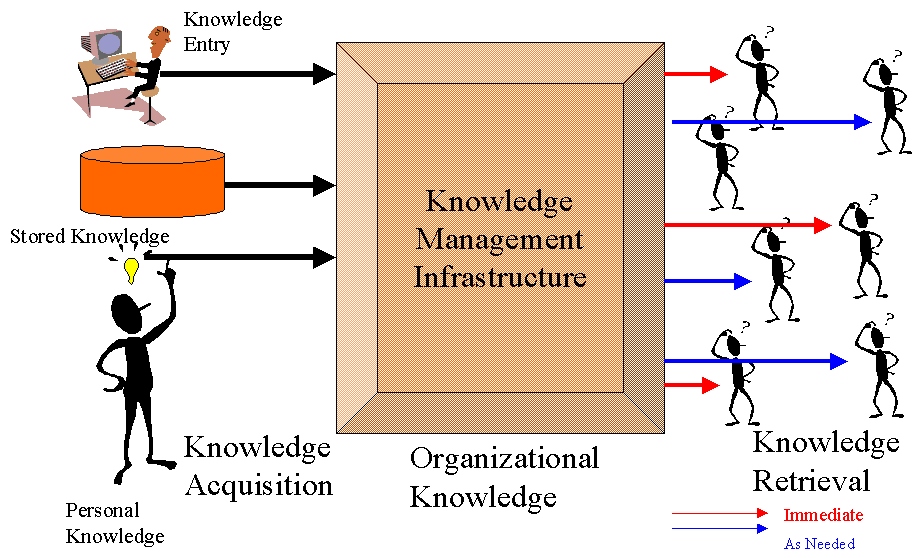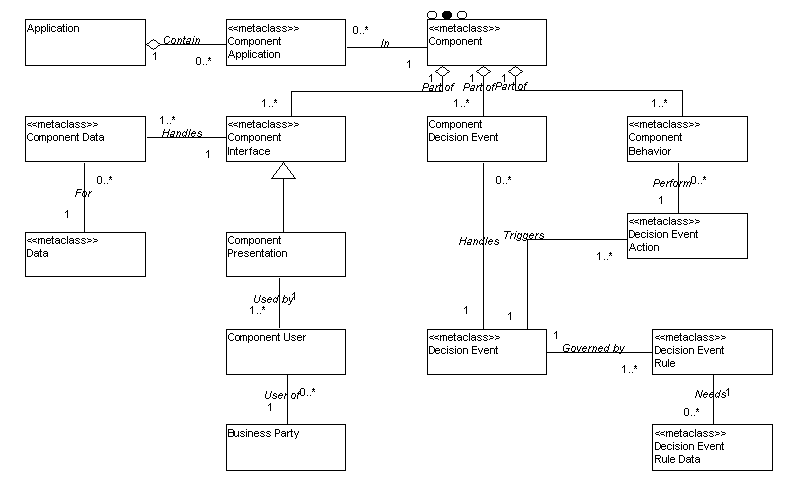Background
While people have criticized Knowledge Management as the same old thing using different words, a well-developed knowledge management system would stimulate the creativity of each employee by
providing exactly the knowledge that employee needs to be optimally creative. We will define knowledge as ideas, information and the relationships between various ideas and information.
Functionally, the ideal knowledge management Infrastructure would take advantage of existing knowledge, stimulate the development of new knowledge and ideas, acquire knowledge directly and
painlessly, automatically classify and interrelate knowledge, make knowledge globally accessible so that the right knowledge could be obtained and effectively utilized by any Knowledge worker who
needs it.
Like any sophisticated system, a Knowledge Management system needs to be well engineered. In this paper, we will discuss using a Component Architecture design approach.
What is Knowledge Management?
Knowledge Management is the discipline that helps spread knowledge of individuals or groups across organizations in ways that directly affect performance. Knowledge Management envisions getting the
Right Information within the Right Context to the Right Person at the Right Time for the Right Business Purpose.

Ideal Knowledge Management Environment
mouse-over to enlarge
How it might work
Knowledge is collected from all existing sources including people, systems, data stores, file cabinets and desktops. All knowledge of value is stored in the organizational knowledge repository. For
virtual teams, this knowledge would be immediately conveyed to those people and systems that could use it. The right knowledge will go to the right person or system at the right time. Current
knowledge can be retrieved from the system at any time in the future. As knowledge becomes obsolete or expires, that knowledge will automatically be removed from the system.
Knowledge Communities
Knowledge Communities are Communities of interest that come together to share knowledge that affects performance. Knowledge Communities operate independent of traditional organizational structure
to find common ground for their category of interest. They are virtual, global communities that are boundary-less and are not hindered by organizational or physical barriers.
Practitioners of Knowledge Management have found that a critical success factor in the implementation of knowledge management is the creation of a cultural environment that encourages the sharing
of information. Knowledge sharing requires the balancing of the natural instinct of people to share work and to receive recognition for it, against the protective instincts that recognize that
creative knowledge can give the enterprise a competitive edge.
Knowledge communities have separate knowledge assets and knowledge access requirements. A knowledge community will have knowledge requirements specific to its area of interest. Because knowledge
communities may have overlapping areas of interest as well as overlapping membership, there are often common knowledge requirements across communities.
Knowledge Assets
Knowledge assets are similar to capital assets. They are usually independent of those who created them and they can be used, moved, and leveraged by others to solve broad-based problems and to
enhance performance. A knowledge artifact is a specific instance of a knowledge asset. These knowledge artifacts may be presented by a browser-based system. They may be embodied as text, diagrams,
graphics, audio, video, or animation.
What is Component Architecture?
A component architecture is a representation of the underlying set of interrelated components that define and describe the solution domain required by the business to attain its objectives and
achieve its business vision. Architecture is an amalgam of engineering art and engineering science.
A component is a self-contained, reusable building block that can be used independently or assembled with other components to satisfy enterprise requirements. A component handles a specific event,
or related set of events, and provides a particular function or group of related functions through a well-defined and stable interface. All components consist of one or more component interfaces,
component decision event handlers, and component behavior activators. The component interface may send or receive data from a file, or may be a user interface. The decision event handler utilizes
business rules to determine which component behavior should be activated.

The Component Meta data Model
mouse-over to enlarge
Knowledge Management Component Architecture
The Knowledge Management Component Architecture consists of knowledge portals, knowledge components, and the knowledge repository.
A Knowledge Portal is a starting point web site where members of a knowledge community begin to enter, find, and access knowledge using the various knowledge artifacts. The knowledge portal may be
designed to focus upon the type of work expected to be done by the knowledge user. Knowledge portal profile modes so far determined are: (1) knowledge subject matter access, (2) collaboration, (3)
community description and, (4) a combination of the above. At times, the knowledge user may wish to focus on knowledge relevant to a project being worked on within the context of the knowledge
community, or he or she may wish to take an enterprise knowledge view.
A knowledge component is a self-contained, reusable object that can be used independently or assembled with other components to satisfy knowledge management requirements. There is the generic set
of architecture issues relevant to all components. Knowledge components have to interface with the knowledge portal, with the knowledge repository, and with other knowledge components. A knowledge
component may need to be customized to handle knowledge of events specific to a given knowledge community. In a like fashion, component behavior may need to be customized to satisfy the special
needs of the specific knowledge community.
The Knowledge Repository consists of servers where knowledge indices and, often knowledge artifacts (documents, presentations, databases, charts, graphs, plans, audio files, and/or video files) are
made accessible. Some searching may cross knowledge servers.
Global Virtual Knowledge Repositories are inter-connectable Knowledge Repositories, globally distributed, that look to be a single entity to portals and knowledge components. One search searches
all.
Maintaining Knowledge Quality
While knowledge components are crucial to a knowledge management system, experts have estimated that 90 percent of the success of knowledge management is involved with gaining the buy-in of
knowledge users and encouraging knowledge sharing. One important aspect of knowledge sharing is obtaining high-quality knowledge and in maintaining its excellence.
One essential aspect of knowledge quality is meaningful classification. Although it may be possible to perform some classification automatically, a considerable amount of manual effort will be
required initially. “Knowledge Journalists” will be required to perform some of these activities. This is not to say that Knowledge Journalists are essential for a functioning Knowledge
Management System.. What it means is that those organizations that require high-quality information need to consider developing Knowledge Journalist professionals.
Knowledge Stewardship (Editorial Board)
Stewardship has been defined as the careful and responsible management of something entrusted to one’s care. Knowledge does not belong to a knowledge community; it belongs to the enterprise.
Therefore, selected knowledge community members should act as stewards of the knowledge to maintain and enhance the quality of the knowledge.
Knowledge stewards need to take responsibility for both appropriate knowledge content and appropriate knowledge presentation.
One knowledge stewardship approach is to set up an Editorial Board for this purpose. The Editorial Board will be responsible for ensuring that both content and presentation of knowledge is
appropriate. Presentation would consider aesthetics as well as the medium (for example, text, graphics, data, audio, video) by which knowledge is conveyed.
Knowledge Content Administration
In addition to Editorial functions, members of the organization will also need to perform Knowledge Management administrative functions. Functions that need to be provided include reviewing and
maintaining knowledge, archiving appropriate knowledge, organizing knowledge etc.
Knowledge Management Tool Administration
Of course, all the tools the Infrastructure will have to be maintained. Maintenance will include common network management functions, server maintenance, as well as administration of all the KM
tools.
